The History of the Festival
In Russia Christmas is celebrated on the 7th of January and marks the birth of Jesus Christ. Christmas is mainly a religious event in Russia. The origin of this festival goes back in the late 10th century and is connected with the baptism of Rus and Prince Vladimir. As you know in most of the European countries, the USA, Canada, Great Britain and some other countries people celebrate Christmas on December 25. As a matter of fact the date is different because the Russian Orthodox Church still uses the old Julian calendar for religious celebrations whereas the Gregorian calendar is internationally the most widely used civil calendar. It was named after Pope Gregory XIII who introduced it in October 1582. The Gregorian calendar is 14 days ahead of the Julian calendar.
In the former Soviet Union Christmas was not celebrated very much. After the October revolution Christmas tree and related celebrations were gradually eradicated. New Year’s Day was the most important holiday of the year. After 1935 the Christmas traditions were adopted as a part of New Year celebrations in Russia. These include the decoration of spruce, family gatherings, the visit by Ded Moroz (Grandfather Frost) and his granddaughter Snegurochka (Snowmaiden).
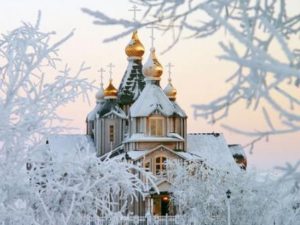
Since 1992 Christmas has become a national holiday in Russia as a part of a ten-day holiday at the beginning of every new year. Lots of churches, chapels and cathedrals have been restored in towns and villages throughout the country. On Christmas Eve (January 6) church-goers visit Christmas services including “All Night Vigil”.
baptism – крещение
spruce /spruːs/ – ель (blue spruce – голубая ель)
- Noun: spruce = fir tree, conifer – хвойное дерево
- Adjective: spruce = nice, smart, elegant, stylish, fine, nice – элегантный, нарядный
- Verb: to spruce = put in order, to dress up, to tidy
- Verb: to spruce = to tell lies, to cheat, to fool, to kid, to deceive
as a matter of fact = actually = really = in fact – на самом деле
calendar /ˈkæləndə/ – календарь
to eradicate /ɪˈrædɪkeɪt/ – искоренять, истреблять
chapel /ˈtʃæpəl/ – часовня
church-goers – прихожане
Christmas Eve – сочельник
All Night Vigil /ˈvɪdʒɪl/ — всенощная (богослужение, которое длится всю ночь, до 4 – 5 часов утра)
Traditional Russian Cuisine
In the evening families have the traditional Christmas Eve “Holy Supper” which consists of 12 meatless dishes, one to honor each of the Twelve Apostles who took part in the Last Supper (Gospel event, the last meal of Jesus with his disciples). Some people don’t eat anything on Christmas Eve until the first star has appeared in the sky. The Russian word for Christmas Eve ‘sochelnik’ comes from the word ‘sochivo’.
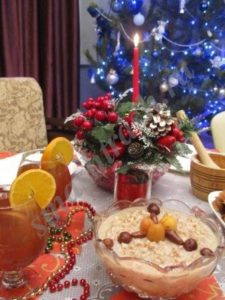
Sochivo
‘Sochivo’ or ‘kutia’ is a kind of porridge made of wheat, buckwheat or rye, served with honey, poppy seeds, fruit (especially berries and dried fruit like raisins), chopped walnuts or sometimes even fruit jellies. From old times till now people are used to treating their relatives and neighbors to this dish. Sometimes ‘kutia’ is eaten from one common bowl which symbolizes unity. In the past some families liked to throw a spoonful of sochivo up on the ceiling. If it was stuck to the ceiling, some people thought that they would be lucky and would get a great crop!
Gospel – Евангелие
disciple /dɪˈsaɪpl/ – ученик, последователь
meatless dishes – постные блюда
wheat /wiːt/ – пшеница
buckwheat /ˈbʌk.wiːt/ – гречиха
rye /raɪ/ – рожь
poppy seeds – мак
dried fruit – сухофрукты
raisins /ˈreɪzən/ – изюм
chopped walnuts /ˈwɔːlnʌt/ – измельченные грецкие орехи
to treat – угощать
bowl /bəʊl/ – миска, чашка
ceiling /ˈsiːlɪŋ/ – потолок
harvest – урожай
Meat and vegetable dishes
Principal dishes on the Christmas table in old Russia included a variety of pork (roasted pig, stuffed pig’s head, roasted meat chunks), jelly (kholodets), and aspic. Some other meat dishes such as goose with apples, sour cream hare, venison, lamb, whole baked chicken and fish were served at Christmas dinner. As a rule all these dishes were made in the Russian oven.
Other popular dishes on Christmas Eve are beetroot soup (borsch) or vegan potluck (solyanka). They are served with individual vegetable pies, often made with cabbage, potato, or mushroom).
Sauerkraut is one of the main dishes on the festive table. It is usually served with cranberries, cumin, shredded carrot and onion rings. It might be followed by more pies or porridge dishes such as buckwheat with fried onions and fried mushrooms.

venison /ˈvenɪsən/ – оленина
chunk /tʃʌŋk/ – ломоть, большой кусок
aspic /ˈæspɪk/ – заливное
lamb /læm/ – баранина (мясо ягненка)
casserole /ˈkæsərəʊl/ – мясная запеканка или запеканка из бобов с овощами
vegan /ˈviːɡən/ – строго вегетарианский
potluck – an informal meal where guests bring a different dish that is then shared with the other guests (http://dictionary.cambridge.org/)
sauerkraut /ˈsaʊəkraʊt/ – квашеная капуста
cranberry /ˈkrænbəri/ – клюква
cumin /ˈkjuːmɪn/ – тмин
shred – клочок, кусочек
shredded carrot – порезанная на мелкие кусочки морковь
Dessert
The festive table cannot do without pancakes, casseroles, pies with various fillings: herbal, vegetable, fruit, meat, cheese and fish. Pies are indispensable dishes not only for Christmas but for the other holidays as well. They can be both closed and open style.
Sweet dishes included berries, fruit, cakes, biscuits, candy, honey were served on the Russian Christmas table. Beverages such as kompot, sbiten, kissel and vzvar were often served at the end of the meal. ‘Vzvar’ or ‘uzvar’ is a sweet drink made of dried fruit (apples, plums, pears, cherries and currants), herbs, spices and honey boiled in water. Sometimes wine can be added. Together with ‘sochivo,’ ‘vzvar’ is a symbol of eternal life and the birth of the Savior.
indispensable — незаменимый
сurrants /ˈkʌrənts/ – cмородина
eternal /ɪˈtɜːnəl/ – вечный
beverage — напиток
the Savior – Спаситель
Traditional Russian Carols ‘Kolyadki’
Initially Christmas in Russia was linked with lots of folk customs. Some areas still keep up with the tradition of carol singing and masking on the night of January 6th. Groups of children and adults, dressed in costumes of manger animals, walk from door to door singing songs called ‘kolyadki’. Some of them are pastoral carols praising the birth of baby Christ, while others are connected with Kolyada, an ancient pre-Christian Slavic goddess of the sun. It was believed that Kolyada could make long winter days warmer and bring sunshine to people’s homes. These songs are widely popular in Ukraine, Belarus and Russia. For their singing people are usually given some money, fruit, sweets and pies.
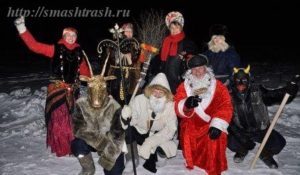
Basically, Christmas was a large and important feast for every Russian family and it still is.
Christmas Predictions and Superstitions
- If there is hoarfrost on the branches of the trees in the first 3 days of Christmas, there will be a rich harvest of grain this year. (Иней на деревьях в первые три дня Рождественских праздников — к обильному урожаю хлеба.)
- If it is warm on Christmas day, the spring will be cold. (Если в этот день тепло — весна будет холодная.)
- If the Christmas night is blizzard, the bees will swarm well. (Если ночью метель — пчёлы хорошо роиться будут.)
- A crescent Moon in the sky on Christmas predicts a lean year. (Если Рождество на новом месяце, то год будет неурожайным.)
- If you see lots of stars in the sky at Christmas night, there will be plenty of berries in the woods, but if you see few stars, it means you will hardly find any berries in the summer. (В ночь звёзд густо — густо и ягод будет, если звёзд мало, то мало и ягод уродится.)
- It is considered a bad omen if the first footer on Christmas is a woman. It means that all the women in this family will have health problems during the year. (Cчитается плохой приметой, если первой на Рождество порог переступит женщина. Это означает, что у всех женщин в этой семье будут проблемы со здоровьем в течение года.)
- Another tradition is to clean the house on this day, to wash in the bath and to set a clean tablecloth for the year to bring good harvest. (Еще одна традиция – это убрать дом накануне Рождества, помыться в бане и постелить чистую скатерть, чтобы год принес хороший урожай.)
- If you put some Christmas biscuits baked in the shape of a cow, sheep or a rooster on the windowsill, you will have a happy and prosperous year. (Считалось, что если в Рождество выставить за окно печенье, испеченное в форме коровы, овцы или петуха, то вас ждет успех и процветание в этом году.)
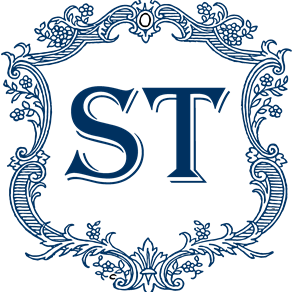

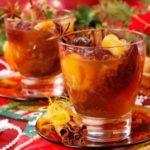
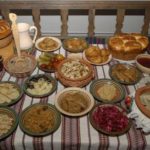
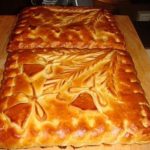
Comment on “Christmas celebrations in Russia”